| Meditation | |
|---|---|
 A bronze cast in the garden of the Musée Rodin | |
| Artist | Auguste Rodin |
| Year | 1886 |
| Type | Sculpture |
Meditation or The Interior Voice is an 1886 sculpture by Auguste Rodin, showing a young woman resting her head on her right shoulder.
| Meditation | |
|---|---|
 A bronze cast in the garden of the Musée Rodin | |
| Artist | Auguste Rodin |
| Year | 1886 |
| Type | Sculpture |
Meditation or The Interior Voice is an 1886 sculpture by Auguste Rodin, showing a young woman resting her head on her right shoulder.
The figure was also used on the right end of the tympanum of Rodin's The Gates of Hell , with a right hand added, extended in horror at the fate that awaits her in Hell. [1]

The figure was also used in Rodin's Monument to Victor Hugo , representing one of the poet's muses. [2] For Gates, Rodin cut off its arms, left knee and part of its right leg. He exhibited the plaster as an independent work in 1896. [3]

François Auguste René Rodin was a French sculptor, generally considered the founder of modern sculpture. He was schooled traditionally and took a craftsman-like approach to his work. Rodin possessed a unique ability to model a complex, turbulent, and deeply pocketed surface in clay. He is known for such sculptures as The Thinker, Monument to Balzac, The Kiss, The Burghers of Calais, and The Gates of Hell.

The Thinker is a bronze sculpture by Auguste Rodin, usually placed on a stone pedestal. The work depicts a nude male figure of heroic size sitting on a rock. He is seen leaning over, his right elbow placed on his left thigh, holding the weight of his chin on the back of his right hand. The pose is one of deep thought and contemplation, and the statue is often used as an image to represent philosophy.

The Musée Rodin in Paris, France, is an art museum that was opened in 1919, primarily dedicated to the works of the French sculptor Auguste Rodin. It has two sites: the Hôtel Biron and surrounding grounds in central Paris, as well as just outside Paris at Rodin's old home, the Villa des Brillants at Meudon, Hauts-de-Seine. The collection includes 6,600 sculptures, 8,000 drawings, 8,000 old photographs and 7,000 objets d'art. The museum receives 700,000 visitors annually.

The Gates of Hell is a monumental bronze sculptural group work by French artist Auguste Rodin that depicts a scene from the Inferno, the first section of Dante Alighieri's Divine Comedy. It stands at 6 metres high, 4 metres wide and 1 metre deep (19.7×13.1×3.3 ft) and contains 180 figures.

The Martyr or The Little Martyr is a c.1885 plaster sculpture of a naked dead or sleeping female figure by Auguste Rodin, now in the Musee Rodin.

Cybele is a sculpture by French artist Auguste Rodin. It is one of the first of Rodin's partial figures known as "fragments" to be displayed as sculpture in its own right, rather than an incomplete study.

The Falling Man is a sculpture by French artist Auguste Rodin modeled in 1882 and is part of Rodin's emblematic group The Gates of Hell.

I Am Beautiful, also known as The Abduction, is a sculpture of 1882 by the French artist Auguste Rodin, inspired in a fragment from Charles Baudelaire's collection of poems Les Fleurs du mal.
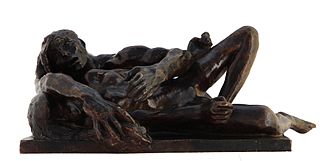
Avarice and Lust is a sculpture by French artist Auguste Rodin, conceived between 1885 and 1887, representing two of the seven capital sins and is part of his sculptural group The Gates of Hell, where it can be found in the lower part of the right door. It's possible that the name was inspired by Victor Hugo's poem Après une lecture du Dante:
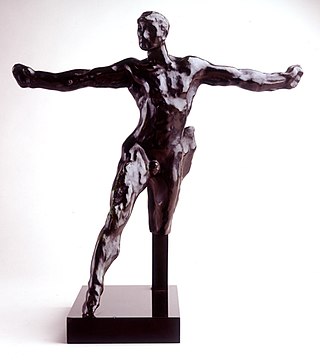
Standing Mercury is a bronze sculpture by French artist Auguste Rodin, first exhibited in 1888. Rodin depicts the mythological god Mercury, son of Maia and Jupiter—messenger of the gods and guide to the Underworld—as a young man, representing eloquence and reason. This depiction is opposite to the traditional representation of Hermes, its Greek counterpart, as a mature man.

Eve is a nude sculpture by the French artist Auguste Rodin. It shows Eve despairing after the Fall.

The Three Shades is a sculptural group produced in plaster by Auguste Rodin in 1886 for his The Gates of Hell. He made several individual studies for the Shades before finally deciding to put them together as three identical figures gathered around a central point. The heads hang low so that the neck and shoulders form an almost-horizontal plane. They were to be placed above the gates looking down on the viewer.

The Kneeling Man is a work originally conceived in 1888 by the French artist Auguste Rodin for his The Gates of Hell project.

Kneeling Female Faun is a sculpture by the French artist Auguste Rodin. A variant of his work The Martyr, it is made of bronze. It was originally conceived in 1884 and exhibited in 1889 in Georges Petit's gallery.

Despair or Despair at the Gate is a sculpture by Auguste Rodin that he conceived and developed from the early 1880s to c. 1890 as part of his The Gates of Hell project. The figure belongs to a company of damned souls found in the nine circles of Hell described by Dante in The Divine Comedy. Other title variations are Shade Holding her Foot, Woman Holding Her Foot, and Desperation. There are numerous versions of this work executed as both plaster and bronze casts and carved marble and limestone.

The Shade, The Slave or The Titan is a sculpture by the French artist Auguste Rodin.
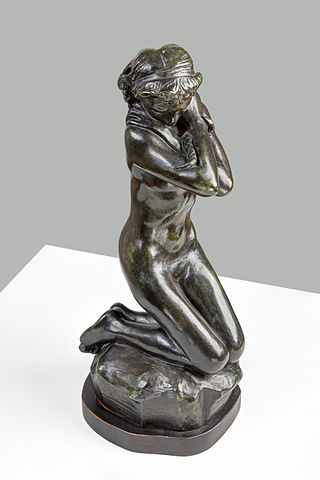
Young Woman with a Serpent is a c. 1885 sculpture by Auguste Rodin, realised in several media. The artist later used the figure in his 1905 Adam and Eve.
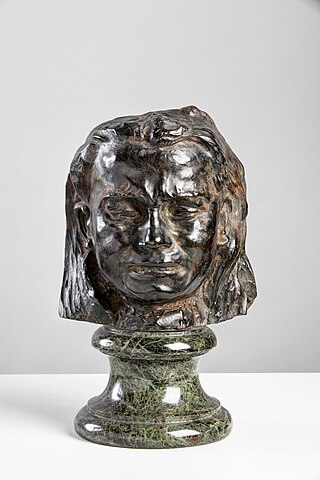
Mask of a Weeping Woman is a sculpture by Auguste Rodin, initially produced as a pair with Weeping Woman for the first version of his The Gates of Hell in 1885. The two pieces were intended to appear on the centre of each panel. They were later moved by Rodin himself, who instead placed Mask on the lower part of the left panel.

Adam is an 1880-1881 statue of Adam by Auguste Rodin, first exhibited at the Paris Salon that year entitled The Creation of Man.
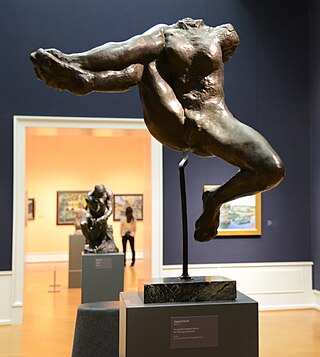
Iris, Messenger of the Gods is a bronze sculpture by Auguste Rodin. A plaster model, created between 1891 and 1894, was cast in bronze by Fonderie Rudier at various times from about 1895. Iris is depicted with her right hand clasping her right foot and her naked body posed provocatively with her legs spread wide, displaying her genitalia.